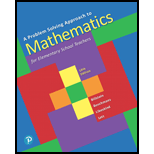
Concept explainers
Use the difference-of-squares formula to simplify each of the following, if possible.
a.
b.
c.
Want to see the full answer?
Check out a sample textbook solution
Chapter 5 Solutions
A Problem Solving Approach To Mathematics For Elementary School Teachers (13th Edition)
- Find the length of the following curve. 3 1 2 N x= 3 -y from y 6 to y=9arrow_forward3 4/3 3213 + 8 for 1 ≤x≤8. Find the length of the curve y=xarrow_forwardGiven that the outward flux of a vector field through the sphere of radius r centered at the origin is 5(1 cos(2r)) sin(r), and D is the value of the divergence of the vector field at the origin, the value of sin (2D) is -0.998 0.616 0.963 0.486 0.835 -0.070 -0.668 -0.129arrow_forward
- 10 The hypotenuse of a right triangle has one end at the origin and one end on the curve y = Express the area of the triangle as a function of x. A(x) =arrow_forwardAre there any unusually high or low pH levels in this sample of wells?arrow_forwardAn angle measures 70.6° more than the measure of its supplementary angle. What is the measure of each angle?arrow_forward
- Please solve the following Probability Problem: Show all work and complete what is askedarrow_forwardPlease solve the following probability problem. Show all work and must solve all parts HW 1.z. (Mingle)A number is called and players need to group up and enter rooms. Ifplayers do not manage to make it into the rooms in time, or if a room hasless or more players than it is supposed to have, they will be eliminated.Assume there are 200 people other than you and the number called is 10.Determine the probability that you will form the group of the correct sizein each of the following cases:a) Imagine you had no better strategy than going to each of the 200people and tossing a fair coin to determine if they will join yourgroup or not.b) Imagine everybody else is divided into 25 groups of 4 people and 20groups of 5 people. Among all the possible groups, you are choosingto join two at random.c) Imagine everybody else is divided into 20 groups of 4 people, 10groups of 2 people and 20 groups of 5 people. You are choosing tojoin two groups at random.d) Imagine everybody else is divided into 20…arrow_forwardIn Problems 17-26, solve the initial value problem. 17. dy = (1+ y²) tan x, y(0) = √√3arrow_forward
 Algebra: Structure And Method, Book 1AlgebraISBN:9780395977224Author:Richard G. Brown, Mary P. Dolciani, Robert H. Sorgenfrey, William L. ColePublisher:McDougal Littell
Algebra: Structure And Method, Book 1AlgebraISBN:9780395977224Author:Richard G. Brown, Mary P. Dolciani, Robert H. Sorgenfrey, William L. ColePublisher:McDougal Littell
 Elementary AlgebraAlgebraISBN:9780998625713Author:Lynn Marecek, MaryAnne Anthony-SmithPublisher:OpenStax - Rice University
Elementary AlgebraAlgebraISBN:9780998625713Author:Lynn Marecek, MaryAnne Anthony-SmithPublisher:OpenStax - Rice University College Algebra (MindTap Course List)AlgebraISBN:9781305652231Author:R. David Gustafson, Jeff HughesPublisher:Cengage Learning
College Algebra (MindTap Course List)AlgebraISBN:9781305652231Author:R. David Gustafson, Jeff HughesPublisher:Cengage Learning Holt Mcdougal Larson Pre-algebra: Student Edition...AlgebraISBN:9780547587776Author:HOLT MCDOUGALPublisher:HOLT MCDOUGALAlgebra & Trigonometry with Analytic GeometryAlgebraISBN:9781133382119Author:SwokowskiPublisher:Cengage
Holt Mcdougal Larson Pre-algebra: Student Edition...AlgebraISBN:9780547587776Author:HOLT MCDOUGALPublisher:HOLT MCDOUGALAlgebra & Trigonometry with Analytic GeometryAlgebraISBN:9781133382119Author:SwokowskiPublisher:Cengage





